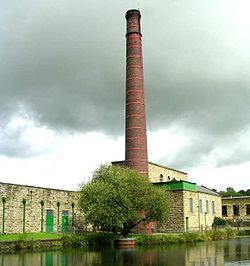Queen Street Mill

Queen Street Mill
|
|
| Cotton | |
|---|---|
| Weaving mill | |
| Architectural style | Single storey |
| Owner | Queen Street Manufacturing Company |
| Further ownership |
|
| Current owners | Lancashire Museums |
| Coordinates | 53°49′N 2°12′W / 53.81°N 2.20°WCoordinates: 53°49′N 2°12′W / 53.81°N 2.20°W 53°49′N 2°12′W / 53.81°N 2.20°W |
| Construction | |
| Built | 1894 |
| Completed | 1895 |
| Floor count | 1 |
| Design team | |
| Awards and prizes and listings | A grade I listed building.No.1416482(25-12-2013) |
| Power | |
| Date | 1894 |
| Engine maker | William Roberts of Nelson |
| Engine type | Tandem compound |
| Valve Gear | Corliss valves operated by Dobson trip gear |
| rpm | 68 |
| Transmission type | Direct drive to line shafts |
| Boiler configuration | |
| Boilers | Twin Lancashire boilers, coal fired |
| Pressure | 140 |
| Equipment | |
| Date | 1894 |
| Manufacturer |
|
| No. of looms | 990 (now 308) |
Queen Street Mill is a grade I listed building. in Harle Syke, a suburb to the north-east of Burnley, Lancashire. It was built in 1894 for the Queen Street Manufacturing Company. It closed on 12 March 1982 and was mothballed, but was subsequently taken over by Burnley Borough Council and maintained as a museum. In the 1990s ownership passed to Lancashire Museums. Unique in being the world's only surviving operational steam-driven weaving shed, it received an Engineering Heritage Award in November 2010. Previously open to visitors and offering weaving demonstrations it was indefinitely closed on 30 September 2016 (except for school parties).
Queen Street Mill is a former working mill that lies within Harle Syke. It is a suburb of Burnley, an industrial town in the North West of the United Kingdom. Harle Syke is approximately 4 km from Burnley town centre and a part of the civil parish of Briercliffe with Extwistle. It is 22 miles (35 km) north of Manchester and 26 miles (42 km) east of Preston, two other former large industrial towns that were significant during the industrial revolution. Harle Syke is on high ground to the south of the River Calder near the M65. The hamlet was built on grid-iron layout and housed seven cotton mills, or weaving sheds.
The Queen Street Mill Manufacturing Company was established in 1894, capitalised with ₤20,000 in £5 shares. The first board of directors was listed as Brierley Edmondson (weaver), William Kippax (weaver), George Lane (builder), John Nuttall (glazer), Thomas Pickles (foreman), John Taylor (weaver), Whitaker Whitaker (weaver), and James Corrin (Headteacher, Haggate School) who became the first company secretary. The company built the Queen Street Mill between 1894 and 1895. As money was scarce only one Lancashire boiler was installed, and it was six years before the second was bought. The weaving shed was single storey, and the mill frontage was three storey. All the looms were bought from Burnley companies, Pemberton & Co. and Harling & Todd Ltd., and have not been replaced. The mill was originally equipped with 900 single shuttle Lancashire looms capable of producing grey cloth. When this was not enough, the company installed a further 366 looms at Primrose Mill, Harle Syke which was the room and power mill immediately adjacent but slightly downhill. To the workers it was known as the bottom shed.
...
Wikipedia

